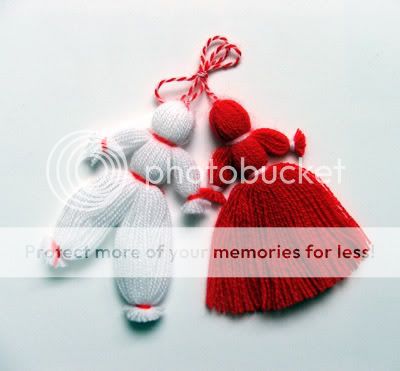Martisor13:36 Mar 30 2009
Times Read: 1,200
 Mărţişor
Mărţişor
(IPA: [mər.tsi.'ʃor])
is the ancient traditional celebration of the beginning of the spring (and until 1701 of the New Year) in Romania, Moldova, Bulgaria and Macedonia (under the name Martenitsa), on 1 March. The day's name is the diminutive of March (in Romanian Martie), and thus means something like "little" or "dear March". Nowadays, men offer women a talisman object also called Martisor, consisting of a jewel or a small decoration like a flower, an animal or a heart, tied to a red and white string. However, giving a little nickel tied to a red and white string is an old custom and was originally designated for both men and women. It was believed that the one who wears the red and white string will be powerful and healthy for the year to come. The decoration is a symbol of the coming spring. A woman wears it pinned to her blouse on this day and up to two weeks after. Occasionally, women also give such gifts to men. In some parts of Romania such as Moldova or Bukovina the symbol of spring was a gold or silver medal which was worn around the neck. After wearing the coin for twelve days, they bought sweet cheese with the medal, because it was believed that their faces would remain beautiful and white the entire year.
Martisor is the symbol of spring and also a celebration on the first of March. Its beginnings are still a mystery, but it is usually said that it originated in ancient Rome, because New Year's Eve was celebrated on the 1st of March (Martius), the month of the war god Mars. He had a double role: both protector of agriculture and of war, so the celebration signified the rebirth of nature. The duality of symbols is kept in the colours of the Mărţişor: white and red, meaning peace and war (it might also symbolize winter and spring).

Origins
For the Thracians, Marsyas-Silen, whose cult was related to the vegetation and the land, had the same attributes. The flower and nature celebrations were consecrated to him.
This custom can be found in all areas where Romanians live. Bulgarian neighbours also have an almost identical tradition on the 1 March, called "Martenitsa".

The tale of Martisor
The story dates back from the time of the Roman occupation of Dacia, during a sun eclipse.It is said that the Sun, looking at the people having fun wanted to enjoy the pleasures of man. So he decided to come to Earth as a young man and take part to the festival. But his happiness was shortly lived because an ogre kidnapped and imprisoned him.
The people were very sad because there was no more sun. The birds would not sing any more, the children weren't happy any more and the rivers stopped flowing. But still nobody dared to face the ogre, until one day when a brave warrior stepped forward and after taking his strength from the people, he went to challenge the ogre.
He had searched for the ogre for three seasons, a summer, a fall and a winter until he had found its castle. When he arrived at the castle the brave warrior faced the ogre and they fought for days, until our warrior killed the ogre. In the end the exhausted warrior, with almost no strength, freed the Sun which immediately started to shine thus bringing spring again into the world. Unfortunately the warrior died before he could see the spring season. His warm blood flowed on to the snow until the last drop; where the drops fell a snowdrop rose.
From that moment on young men make a white and red string wich they offer to the girls whom they love or to those close to them, the red colour reminds us of the warrior’s blood and the white is a symbol of health, purity of the snowdrop and the first flower of spring.

Another legend about Martisor
At the end of the XIX-th century, children received a "martisor" from their parents, on the first day of March, before sunrise. This was made from a gold coin and the string was made from two strings: one white and one black, or white and blue twisted together. The black colour represents the black fur which old woman Dochia gave to her daugther-in-law and symbolises the darkness of winter. The white part symbolises spring.
The fur, in the legend, changed colour from black to white through the sacrifice of the girl, the daughter-in-law of old woman Dochia. Because of this, the red side symbolises sacrifice and blood.
It is said that the string from the "martisor", a rope of 365 or 366 days, was sown by old woman Dochia as she went up the mountain with her sheep. Like the fortune-teller that sew the string of life for each new baby, old woman Dochia sows the string of the year.
The richer families had "martisoare" with the string made of silver and gold. Children would wear it tied to their hand, on their chests or on their necks. The "martisor" was showed at certain feasts like "Macinii", "Florii", Easter and "Arminden" - and it was tied to the branches of trees.
What was the meaning of all this ritual ? It is believed that those who wear "martisor" will not be burned by the Sun during the summer and that they will be healthy, lucky and beautiful like flowers.
After some time, marbles, beautifully colored, took the place of the coin.
The "martisor" is actually a remnance of a ritual to renew the time during spring, at the symbolic death and rebirth of Dochia.


















COMMENTS
-